什么是荒野(Wilderness)?
在2016年的《当代生物学》中,研究人员将其定义为:未受工业活动影响、但不一定没有人类存在的大片景观。
那么荒野有什么呢?
在《天人和谐:生态文明与绿色行动》一书中,作者是这样定义的:“这里,没有主义,没有宗教,没有科学,没有制度,亦无所谓的人的资源,没有益虫益兽、害虫害兽。....这里有光明与黑暗、生机与死亡、协调与对抗、天资与炫耀、庄严与美丽、灾变与荣幸、汗水与血肉、草木与鲜花,有能量转移与生物进化......”
然而,随着人类活动的日益频繁——能源开采、非法狩猎、非法走私、非法采矿等活动——荒野的流失速度远远超过受保护的速度。2016年《当代生物学》(Current Biology)的研究表明,自1992年召开的里约地球峰会以来,仅有250万平方公里的荒野得到保护,而由于各种各样人为原因损失的荒野面积高达330万平方公里。
荒野从来都是我们追求“天人合一”的最佳之处。一平方米的荒野,所载养的生物多不胜数,要与大自然亲密接触,实在容易至极。
荒野可以维持生态系统正常运行,提供大量的自然资源,为人们提供休憩之地。
因此,我们需要保护荒野这个大自然银行,使之收支平衡。
2018年1月20日,第十一届“世界荒野大会”在北京举办启动仪式,标志着第十一届世界荒野大会2019年将落地中国。世界荒野大会在中国举行有着非常重要的意义,我们应该要向各方汲取经验。
在欧洲,荷兰一环保专家弗兰斯·舍佩尔斯(Frans Schepers)为首的许多自然保护者正致力打造欧洲荒野再生计划(Rewilding Europe),他们希望将欧洲部分地区重新变成荒野,以促进野马、猞猁以及欧洲野牛等野生动物的复兴。
目前,科学家们正在进行试验,致力于让野马、野牛、马鹿等大型动物重新出现在欧洲大陆上。他们希望尽可能多地增加物种多样性,为因人类活动而失去栖息地的动物寻找新家。
以下是欧洲荒野再生计划代表在近日所做的演讲稿及ppt,现分享如下,与读者共勉:
PPT 1:
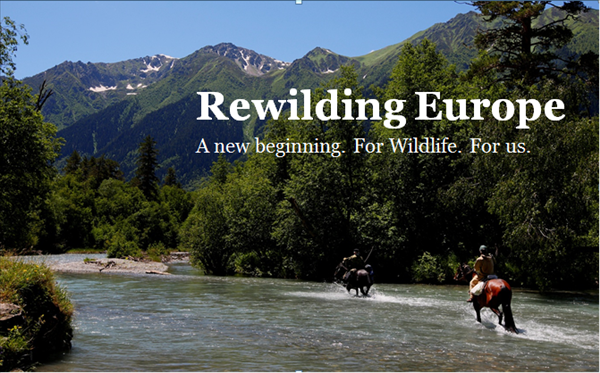
现在,我们正在欧洲实施一项新的计划。在欧洲这个已经开发的大洲,我们拥有着独一无二的历史性机会。我们称这项新计划为“欧洲荒野再生”计划。这对野生动物和人类来说,都是一个全新的开始。此项计划提议将多样的生物带到欧洲被抛弃的土地上。这次演讲,我将会向大家介绍该项计划的内容、目标、实现方法和合作伙伴。
Today we are launching a new initiative in Europe. It is about a unique, historical opportunity we are facing in our cultivated continent. An initiative we call “Rewilding Europe’ A new beginning, For Wildlife. For us.’’It is about bringing the variety of life back to Europe’s abandoned lands. In my presentation I will explain you more what this initiative is about, what it will try to achieve, how and with whom.
PPT2:
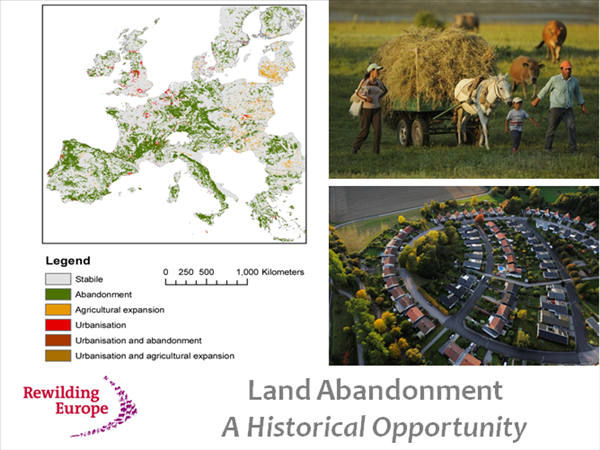
那么,这项计划会提供怎样独一无二的历史性机会呢?现在,城市化发展,农村人口减少,同时欧洲乡村的大规模土地被废弃。这并非是个问题,反之,这个状况创造了前所未有的机会,世界人口众多的的大洲之一会重新拥有“野生”的自然。大部分的绿色区域,不需要再去解决农业竞争问题。
So what is the unique, historical opportunity this initiative will build on? It is the urbanisation and depopulation of rural areas and the resultant large-scale land abandonment of the European countryside. Instead of being perceived as a problem, this creates an unprecedented opportunity. For the return of wild nature on one of the most crowded continents in the world. Large areas, here indicated in green, do not cope any longer with agricultural competition
PPT 3:
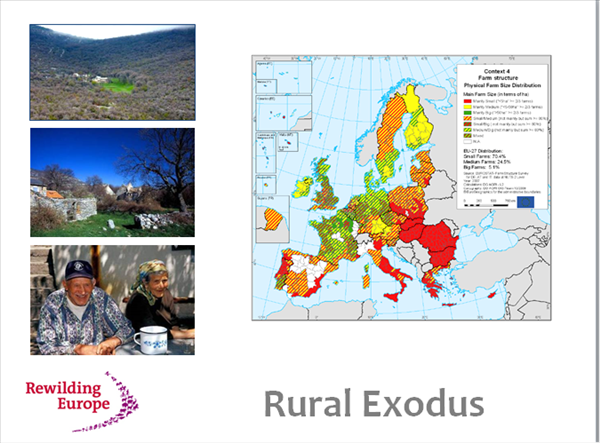
而且,很多地方下一代几乎都不再使用土地。我们找到了欧洲环境政策研究院(IEEP)提供的有关最新信息,今天将会发行有关信息。尽管有许多不确定性而且缺乏相关数据,据估计2030年将有1200万到1700万公顷土地将被闲置。而这是欧洲面积的3%到4%。如果加上过去十年被抛弃土地的面积,那么该数据就要翻一番。欧洲许多地区的土地都正处于闲置状态
Moreover, in many of these areas, there is virtually no next generation to use the land. We have asked IEEP, the Institute for European Environmental Policies, to provide us an update based on the latest information. This new publication will be available today. And although with some uncertainties with all the modelling and lack of data, it is expected that by 2030, an additional 12 to 17 million hectares will be abandoned. This is 3-4 % of Europe. If we add up the areas that have already been abandoned in the last few decades, we talk about maybe double this size. So land abandonement is actually happening in quite a number of areas in Europe
编者按:在中国,根据国家土地督察机构2017年发布的《国家土地督察公告》称,2014年专项督察发现的105万亩闲置土地,至2016年底,全国105万亩闲置土地已处置完毕98.22万亩,处置比例为93.6%。
试想,倘若把一半的闲置土地运用在荒野重建上,这会对中国生态保护上有着这多大的影响。
PPT 4:
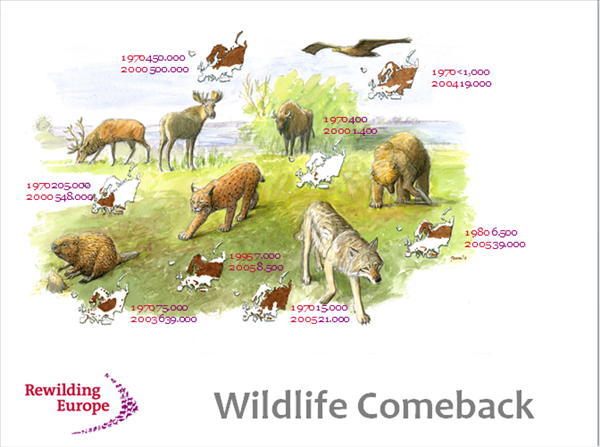
尽管有土地弃耕,但同时,我们可以看到有大量的野生动物重返欧洲。自工业革命以来我们就没有见过这种情况,大量的物种正在增加和扩大其栖息范围。根据最新发布的世界自然基金会《地球生命力报告2010》,1970年至2007年,欧洲动物种群数量平均增长了43%。在这张图片中你看到一些例子,我们认为“更好的环境保护”是主要的促成因素,随着土地弃耕,土地使用上最近也发生许多了变化,有助于减少狩猎和提高许多生态系统的生产力。许多种野生动物回归森林,特别是哺乳动物和鸟类。我们应该庆祝在环境保护上取得的巨大成功!让我们来看看其中的一些物种
Despite these developments, and at the same time, we see a spectacular and significant wildlife comeback in Europe, we have not seen this before since the industrial revolution. Quite a large number of species are increasing and expanding their ranges. According to the 2010 WWF Living Planet report, launched recently,- the periode between 1970 and 2007 saw an averege increase in animal populations of 43% in Europe. In this picture you see some examples. ”Better environmental protection’’’is claimed to be a major contributing factor,
But also recent changes in landuse with abandonment of farmland reduced hunting pressure and higher productivity of many ecosystems probably also played an important role. The wildlife come back encompasses a long list of species, particularly mammals and birds. A huge conservation success we should celebrate! Let’s look at some of these species.
编者按:绿会秘书长、IUCN荒野专家组成员周晋峰博士于6月1日在北京大学再次召开的保护校园生物多样性论证会上,针对北大的“校园保护地”这一创新理念提出了许多宝贵意见。其中提到应该要重视乡土植物,防止城市“一刀切”式的绿化,让北京1400多种野生植物有机会自然“野蛮”生长。相信充分利用校园面积,重建荒野地带,扩大野生动物栖息地,吸引更多野生生物返回荒野,重建家园,真正达到人与自然和谐相处的状态。
PPT 5-7

野牛——唯一散养的物种
Bison – only free-roaming populations
1970年——400只
2000年——1400只
2010年——2000只

白尾海雕
White-tailed eagle
1970年——少于100只
2004年——19000只
2010年——进一步增加
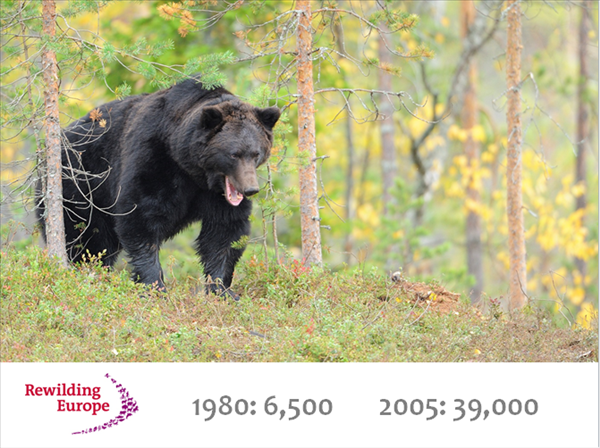
棕熊
Brown bear
1980年——6500只
2005年——39000只
2010年——逐渐增加
PPT 8:

过去几年,欧洲议程对荒野保护议题非常感兴趣。Ladislav Miko稍后会详细解说。
这项重要决议的采取标志着荒野保护在政治上的里程碑。2009年2月和5月,超过230位代表共同于布拉格参加“荒野和大型自然栖息地会议”。荒野保护和再生成为了欧盟生物多样性保护政策和法律框架的一部分。这些进展为我今天所讲的欧洲荒野再生计划的未来工作奠定了宝贵的基础。
Wilderness has gained a lot of interest on the European agenda during the last few years.
Ladislav Miko will tell us more later this morning. Political milestone was the adoption of very important resolution. In February 2009 and May 2009, more than 230 representatives met in Prague at the Conference on Wilderness and Large Natural Habitat Areas. Wilderness and restoration of wild areas is becoming part of the legal framework and the new EU strategy for Biodiversity. These developments provide an invaluable basis for the future work or Rewilding Europe, the initiative I am talking about here today
本文PPT均来自于Rewilding Europe。
文/啊Cat, Mine 核/芝麻 编/Angel


